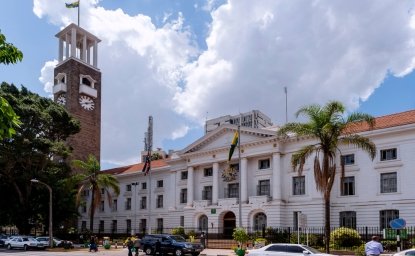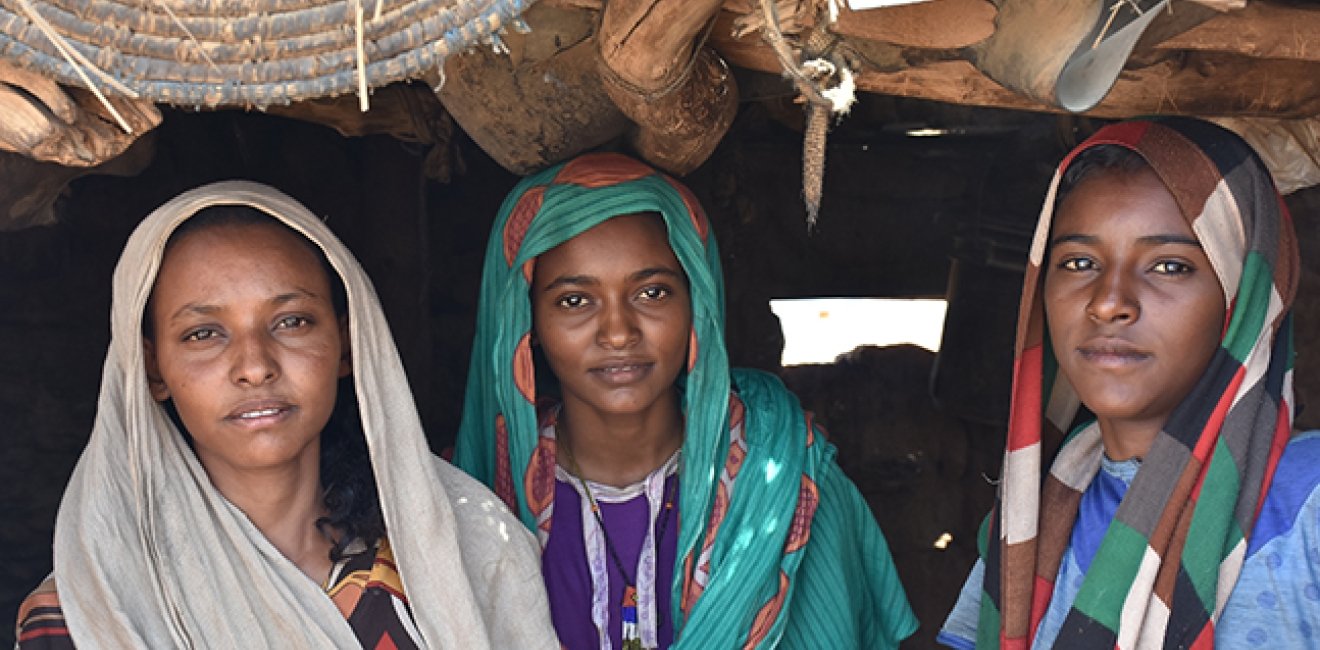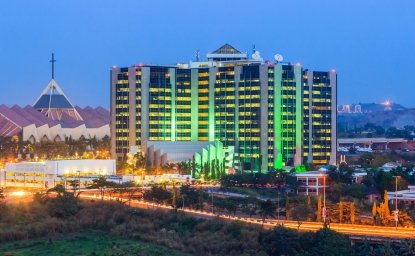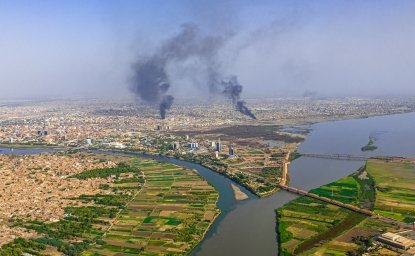
A blog of the Africa Program
Growing up as a Black man in the United States, I am all too familiar with how racism shows up in our society today. From slavery and Jim Crow laws of the past to police brutality and mass incarceration in the present, American racism is well documented. However, a fact that tends to be overlooked is that anti-Blackness is a global phenomenon, present in many countries. One such country is Sudan. Though I've grown up in the United States, my family always made sure I was in touch with my relatives overseas, and I've grown to love the country my parents were born in. However, as I grew older and participated in discussions with other Sudanese, I began to recognize that Sudan has its own battles when it comes to prejudices, showing up in the form of mass internalized anti-Blackness. Inspired by the Black Lives Matter (BLM) movement happening around me in the United States, I decided to explore the issues of colorism that have developed in Sudan over many generations.
Sudan, the ancient land of the Kushite and Nubian civilizations, is situated in the northeast of Africa and has a long history of cultural ties to the nearby Arabian Peninsula — including a history of Arab influence that impacted Sudan's national identity (Rehman). When Arabs arrived in the area in the 7th century, they called it bilad al-Sudan, which is Arabic for "land of the Blacks." The Nubians had Africoid facial features, and their skin color ranged from jet-black to various shades of dark and medium brown. These racial characteristics are still the reality for Sudanese people today. The gradual Arab intermixture with the indigenous Black Sudanese has not substantially altered their appearance.
Despite the fact that there are a few Sudanese who are relatively lighter skinned, the majority are dark-skinned. This begs the question: how could there be anti-Blackness in a country where everyone looks the same? How is it bad to be Black in a country literally named "Land of the Blacks?" How is there anti-Blackness when everyone's Black?
To understand Sudan's identity crisis, it is important to have a general knowledge of Sudan's political history and how events of the past century have affected the country. In the 20th century, North and South Sudan were ruled as a single country under a joint colonial relationship between the United Kingdom and Egypt. This period of colonial rule forced the Sudanese people to see themselves as a unified nation, whereas previously they had been living in self-governing tribes. British colonial policies favored a narrow elite group from within Arab communities, who were largely Muslim and Arabic-speaking. As a result, ever since Sudan's independence in 1956 the northern "Arabs" have been the country's ruling elite. An attempt to build a strong Sudanese national identity was undertaken, and certain customs came to represent a unified idea of Sudanese culture, informed by Islam and certain aspects of traditional Arab tribal culture. Much of Sudan's legislation became based on Muslim Sharia law in 1989, occurring as part of a wave of "public morality" that, for example, required women to wear modest clothing, regardless of their religious beliefs. The Sudanese government also promoted a policy called "ta'rib," or "Arabization," that sought to make Arabic the standardized language across the country.
This vision of the national identity did not resonate with the tribes of southern Sudan. In contrast to their northern counterparts, most of southern Sudan's tribes were of African heritage and the majority of them were Christian. However, Sudanese laws implied an inferior status for the non-Muslim, non-Arab population, thus southern Sudan's African-identifying citizens were religiously and politically marginalized and suffered discrimination due to their skin color.
This is because southern Sudanese came from a region that had long been a source of slaves. In fact, Khartoum, the current capital of north Sudan, was founded as a marketplace for slave-trading, and in the second half of the 19th century, about two-thirds of the city's population was enslaved. Sudan became one of the most active slave-raiding zones in Africa, with slaves transported from the south to the north, including to Egypt, the Middle East, and the Mediterranean. To this day, the association of darker skin with slavery prevails throughout Sudan.
The practice of slavery in Sudan was abolished by the British administration in 1924. However, many of the men and their families who strongly opposed this decision continued to wield enormous influence in Sudan after independence, entrenching notions of Arab superiority in the new state by reserving almost all jobs for Arabs and failing to develop areas inhabited by Black people. Today, in any government department or bank in Khartoum, one rarely sees a Black person in an important role, and outside of urban areas, where the population is primarily Black, the region is overwhelmingly underdeveloped.
The superiority complex of many members of the Arab elite lies at the heart of some of the worst conflicts to hit Sudan since independence, as Black people either demand equality or their own homeland. Sudan experienced two civil wars between the north and the south, leading to the south officially seceding in 2011 and forming South Sudan. Meanwhile, the conflict in Sudan's western region of Darfur has been described as "the world's worst humanitarian crisis" by the United Nations and a genocide against non-Arab pastoralist ethnic groups. The number of fatalities in both conflicts — South Sudan and Darfur — is in the millions, and they both stem from the Afro-Arab identity crisis that has long afflicted Sudan.
Millions of civilians living in the conflict regions have been forced to relocate to Khartoum, a city where there is the misconception that Sudanese Arabs are considered true Sudanese, whereas Sudanese Africans are seen as subordinates, and where a preference for lighter skin exists. So, when refugees from the south or the west flee to Khartoum, they face discrimination and prejudice due to their darker skin. This colorism shows up in many ways, including when parents tell their children not to befriend kids coming from the south; when adults tell young girls not to stay out in the sun too long for fear of becoming dark and ugly; when media outlets describe petty criminals as "negroes" since they are perceived to be poor; and when parents forbid their daughters from marrying an "abeed," a derogatory term used against dark-skinned Sudanese that means "slave." Many Sudanese, especially women, have resorted to the use of skin-bleaching products to whiten their skin, because light skin is seen as a sign of beauty. When their wedding day comes around, they are pressured into using these products, which have been linked to cancer, for fear of being ostracized by their friends, family, and community.
The contradiction of all this is that most of Sudan's population, even top-ranking government officials of the "Arab elite", are African in appearance, and an outsider would be hard-pressed to tell the difference between a northerner and a southerner. As mentioned before, the intermixture of Arabs with indigenous Black tribes centuries ago did not really alter Sudanese' appearance. Therefore, the framework for disentangling the colorism and identity crisis Sudan faces cannot simply be transferred from the BLM movement in the United States, but must be unique to Sudan's situation.
Mustafa Abubakr is a pre-law student studying Sociology and International Relations and Diplomacy at The Ohio State University. He was a Stafford Capacity Building Intern with the Wilson Africa Program in 2020.
Cover image: A portrait of young Sudanese woman in Merowe, Sudan on November, 19, 2017. Credit: Claudiovidri/Shuterstock. Source: https://www.shutterstock.com/image-photo/merowe-sudan-november-19-2017-potrait-1140048071.
Citations:
Amir Ahmed, "Ending Sudan's Identity Crisis." The Guardian, June 10, 2011, www.theguardian.com/commentisfree/2011/jun/10/sudan-identity-crisis-north-south.
Deng Aling, "Exploring the Identity of Sudanese Culture. Is It Arabic or African?" This Is Africa, Feb 16, 2016, https://thisisafrica.me/african-identities/16613-2/.
Manu Ampim, "Racial Identity In The Sudan: Dispelling Popular Myths." Manu Ampim - Racial Identity in the Sudan, Jan 21, 2008, https://manuampim.com/racialD2.html.
Nina Evason, "North Sudanese Culture." Cultural Atlas, https://culturalatlas.sbs.com.au/north-sudanese-culture/north-sudanese-culture-core-concepts.
Sebabatso C. Manoeli, "'We Have No Harlem in Sudan'." Africa Is a Country, June 29, 2020, https://africasacountry.com/2020/06/we-have-no-harlem-in-sudan.
Fareeha Rehman, "The Sudanese Identity." Fourth Estate, April 24, 2017, http://gmufourthestate.com/2017/04/24/14888/.
Zeinab Mohammed Salih, "Viewpoint from Sudan - Where Black People Are Called Slaves." BBC News, BBC, July 25, 2020, www.bbc.com/news/world-africa-53147864.
Author


Africa Program
The Africa Program works to address the most critical issues facing Africa and US-Africa relations, build mutually beneficial US-Africa relations, and enhance knowledge and understanding about Africa in the United States. The Program achieves its mission through in-depth research and analyses, public discussion, working groups, and briefings that bring together policymakers, practitioners, and subject matter experts to analyze and offer practical options for tackling key challenges in Africa and in US-Africa relations. Read more

Explore More in Africa Up Close
Browse Africa Up Close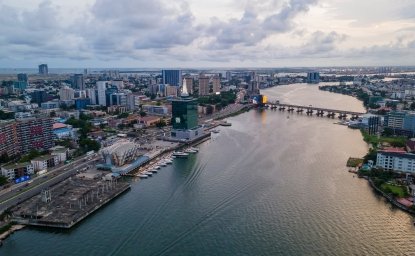
The Innovative Landscape of African Sovereign Wealth Funds
